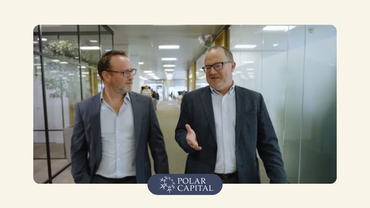Investment Trust glossary
The Investment Trust industry is awash with acronyms and abbreviations, and although they can be great for getting a point across quickly, they're not much help if you don't know what they mean to begin with. But never fear! We've busted the jargon with a list of some of the most commonly-used terms and phrases related to Investment Trusts, so you can get your head around the confusing terminology once and for all.

A
Actively managed
Investment Trusts are all actively managed, which means they have a fund manager who makes active decisions about which stocks the trust should be invested in - rather than passively tracking an index or benchmark, like passive ETFs do, for example. The advantage of being actively-managed is that the trust benefits from the time and skills of the fund manager who can make round-the-clock decisions about the underlying investments, allowing the trust to adjust or pivot in response to market events.
Asset
Assets are another word for the underlying investments that make up an Investment Trust, and are often described in terms of which asset class they belong to, such as company shares, property, bonds or cash. A key feature of a well-diversified investment portfolio is one which invests across a range of different asset classes. So in theory, if the stock market has a particularly bad year and any company shares you own take a hit, you won't lose everything as your portfolio will be protected by investments in other types of assets which (hopefully!) haven't been affected.
AUM
AUM stands for ‘Assets Under Management’ and refers to the total value of an Investment Trust. In other words, it shows how much investor money has been put into it based on today’s valuations. If 1,000 investors put £1 into an Investment Trust this week, there will be £1,000 AUM. And if the market goes up by 10% next week, then the AUM will rise to £1,100.
B
Benchmark
A benchmark is the standard against which an Investment Trust is measured, for example, to calculate relative performance or risk exposure. It’s often another index made up of comparable underlying assets.
C
Closed ended
All Investment Trusts are closed ended, which means that there are a finite number of shares in any given trust that you can purchase. This differs from other types of funds, where new shares can be issued whenever an investor makes an order to buy one. Investment Trusts, on the other hand, have a limited supply and this enables them to occasionally trade at a higher or lower price than their Net Asset Value (NAV) in response to investor demand.
D
Discount
A discount refers to when an Investment Trust's shares are trading at a lower price than the innate value of its underlying investments - its NAV - thanks to that closed-ended structure we explained above. Some investors opt to purchase Investment Trust shares while they're trading at a discount in the hope that they might make a profit when the shares go up in value again - though this is never 100% guaranteed to happen.
Diversification
This is the term used to describe the method of spreading your investments across a range of different types of assets - such as shares, bonds and property - to minimise risk should any particular part of your portfolio perform poorly. The idea is that, by investing in a swathe of different things, you won't be as badly affected as if your entire portfolio was invested in just one thing if it all goes wrong. Basically, it's the act of NOT putting all your eggs in one basket!
Dividends
Dividends are a type of income you can earn from Investment Trusts as a sort of cash "thank you" for investing in them. What's not to like? The best part is that Investment Trusts have the unique ability to set aside up to 15% of their income every year to boost dividends when times get tough, making them a great choice for investors who want a steady and reliable income from their investments.
E
Exposure
Exposure is the proportion of an Investment Trust which is invested in a sector, asset class or region, usually expressed as a percentage of the overall portfolio. For example, a trust with 75% exposure to technology would have 75% of its assets invested in technology sector stocks.
G
Gearing
Gearing is the term given to when an Investment Trust borrows money in order to purchase more investments. This might be because the fund manager thinks they have spied an opportunity to purchase a particular stock before it goes up in value, for example. The theory is that, in borrowing funds to purchase this stock, the trust is able to magnify its profits and cover the cost of the loan it took to do so. However, it works both ways, and if the trust makes a loss then it's got debt to worry about on top of that as well. You can read more about how gearing works here.
I
Index
An index is a basket of assets or securities designed to represent a market or submarket. For example, the S&P 500 is a popular index which is representative of the 500 largest companies listed on the American stock exchanges by market capitalisation (see below). Indices track the performance of the relative market and are often used as a benchmark for investors or portfolio managers.
Investment Trust
An Investment Trust is an investment product where you (and a bunch of other investors) pool your money together for a fund manager to invest in things – such as shares, bonds, property, and so on – with the aim of making a profit. You can read more about what trusts are and how they work here.
M
Market capitalisation
Also sometimes referred to as 'market cap', this is a measure which describes the size of an Investment Trust. It's calculated by multiplying the number of shares by the price of the shares. For example, if a trust has 100 million shares, and each share is worth £2, its market capitalisation would be £2m.
N
NAV
The NAV (or Net Asset Value) of an Investment Trust is the value of all its underlying investments. You can think of it as its innate value before things like premiums and discounts come in to affect the share price.
O
Ongoing charge
Also called the 'Total Expense Ratio' or 'TER', this is a measure of the total cost of investing with an Investment Trust. It can include fees and charges such as trading fees, legal fees, auditor fees, and other expenses involved in the running of the trust. The ongoing charge is important for one key reason - it affects your returns. Say for example that your trust generates returns of 5% for the year, if the ongoing charge is 4%, you'd only get to take home 1% in profit. You can find out the ongoing charge of an Investment Trust on its profile on the Association of Investment Trusts' website - just search for your trust here.
P
Premium
The opposite to a discount. An Investment Trust trades at a premium when its shares are trading at a higher price than its NAV. This can be for a number of reasons, but is usually because investor demand for the trust is high, such as if it's been performing well of late or it's expected to deliver good returns in the near future. Good news if you've already got an Investment Trust and you're looking to sell, but not so good if you're trying to get your foot in the door and buy one.
V
Volatility
Volatility describes the price movement of an investment. High volatility indicates frequent and significant price movement, whereas low volatility denotes less frequent or severe fluctuations in price. In investment speak, risk actually means high volatility.
Y
Yield
The yield is the return on an investment, usually expressed as a percentage of the total price. So for example, if the yield on a bond is 5%, this means an investor with £100 in that bond, would get £5 of income a year.



